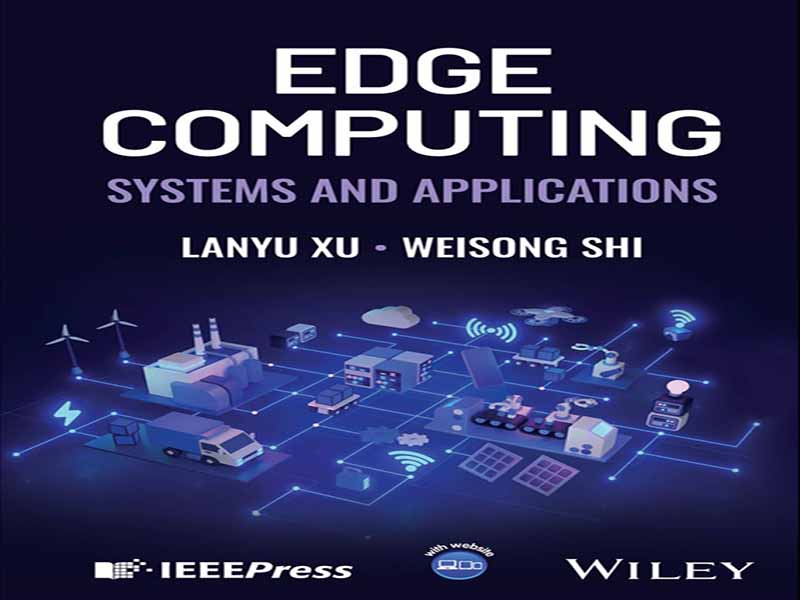- عنوان کتاب: Edge Computing -Systems and Applications
- نویسنده: Lanyu Xu Weisong Shi
- حوزه: محاسبات لبه
- سال انتشار: 2025
- تعداد صفحه: 418
- زبان اصلی: انگلیسی
- نوع فایل: pdf
- حجم فایل: 6.58 مگابایت
در طول دهه گذشته، تکامل سریع محاسبات لبه، اساساً نحوه پردازش، ذخیره و استفاده از دادهها را در بخشهای مختلف صنعت، مانند تولید هوشمند، مراقبتهای بهداشتی، شهرهای هوشمند و حمل و نقل، متحول کرده است. محاسبات لبه به عنوان یک عامل حیاتی برای فناوریهایی مانند اینترنت اشیا (IoT)، سیستمهای خودران و تجزیه و تحلیل بلادرنگ، از یک مفهوم نوپا به پذیرش گسترده رسیده است. با وجود این رشد قابل توجه، همچنان کمبود منابع آموزشی اختصاص داده شده به تجهیز نسل بعدی نیروی کار به دانش و مهارتهای لازم برای پیشرفت بیشتر محاسبات لبه وجود دارد. این کتاب با ارائه مقدمهای جامع از اصول، معماریها، کاربردها و چالشهای محاسبات لبه، برای رفع این شکاف انگیزه یافته است. هدف آن ارائه پایهای محکم در محاسبات لبه به خوانندگان، از دانشجویان گرفته تا متخصصان، است تا آنها را قادر سازد وضعیت فعلی آن را درک کنند، با چالشهای آن مقابله کنند و توسعه آن را هدایت کنند. این کتاب با پیوند دادن نظریه و عمل، الهامبخش نوآوری، تقویت همکاری و ترویج رشد در این زمینه به سرعت در حال تحول است. این کتاب که هم به عنوان کتاب درسی و هم به عنوان راهنمای مرجع طراحی شده است، شامل سوالات تمرینی، پروژههای درسی و مطالب خواندنی منتخب برای هر فصل برای افزایش یادگیری است. خوانندگان با علایق و اهداف متنوع میتوانند مستقیماً به فصلهای مرتبط با خود دسترسی پیدا کنند و این کتاب را به منبعی انعطافپذیر برای دانشجویان، مربیان، محققان و متخصصان تبدیل میکند. این کتاب در نه فصل ساختار یافته است. فصل 1 اهمیت محاسبات لبهای را معرفی میکند و پیشینه و تاریخچه تکاملی آن را ارائه میدهد. فصل 2 مبانی را مطرح میکند و اصول، مدلها و فناوریهای اساسی زیربنای محاسبات لبهای را پوشش میدهد. فصل 3 به معماری و اجزای محاسبات لبهای، از جمله زیرساختها و مدلهای مشارکتی، میپردازد. فصل 4 با برجسته کردن ادغام هوش مصنوعی با محاسبات لبهای، به هوش لبهای میپردازد. فصل 5 به چالشهای کلیدی مانند قابلیت برنامهریزی، بهینهسازی منابع و امنیت میپردازد و در عین حال راهحلهای بالقوه را پیشنهاد میدهد. فصل 6 به آینده نگاه میکند و در مورد الگوهای نوظهور مانند محاسبات آسمانی، 6G و محاسبات لبهای در اکتشافات فضایی بحث میکند. فصل 7 از طریق مطالعات موردی دنیای واقعی، بینشهای عملی ارائه میدهد و تأثیر محاسبات لبهای را بر صنایعی مانند تولید، مراقبتهای بهداشتی، شهرهای هوشمند و موارد دیگر نشان میدهد. فصل 8 نگرانیهای مربوط به حریم خصوصی و شکاف دیجیتال را بررسی میکند و سوگیریها، تأثیرات آنها و استراتژیهای کاهش در محاسبات لبهای را بررسی میکند. فصل ۹، کتاب را به پایان میرساند. این تلاش بدون فداکاری و تخصص بیدریغ تیم پشت این کتاب امکانپذیر نبود. ما عمیقاً از مشارکتکنندگان، ویراستاران و داورانی که بینش و تلاش سخت آنها این کتاب را شکل داده است، سپاسگزاریم. به طور خاص، از دکتر هایهوا چن (دانشگاه شمال تگزاس)، دکتر شیهونگ هو (دانشگاه هوهای)، دکتر سیدی لو (ویلیام و ماری)، دکتر کیوی شا (دانشگاه شمال تگزاس)، دکتر چینگیانگ ژانگ (دانشگاه آنهویی)، دکتر شینگژو ژانگ (آکادمی علوم چین) و دانشجویان دکترا کومالا سوبرامانیام چروکوری (دانشگاه شمال تگزاس)، یوانکای هی (دانشگاه دلاور)، شیبال ساها (دانشگاه اوکلند)، کیرن وانگ (دانشگاه دلاور)، ییچن شیا (دانشگاه دلاور) و یونگتائو یائو (دانشگاه دلاور) صمیمانه تشکر میکنیم. برای همه خوانندگان، امیدواریم از خواندن کتاب لذت ببرید و این کتاب را به عنوان یک منبع و الهامبخش در کاوش دنیای هیجانانگیز محاسبات لبهای بیابید.
Over the past decade, edge computing’s rapid evolution has fundamentally transformed how data is processed, stored, and utilized across multiple industry sectors, such as smart manufacturing, healthcare, smart cities, and transportation. As a critical enabler of technologies such as the Internet of Things (IoT), autonomous systems, and realtime analytics, edge computing has progressed from a nascent concept to widespread adoption. Despite this remarkable growth, there remains a lack of educational resources dedicated to equipping the next generation of the workforce with the knowledge and skills needed to advance edge computing further. This book was motivated to address that gap, offering a comprehensive introduction to edge computing’s principles, architectures, applications, and challenges. It aims to provide readers, ranging from students to professionals, with a solid foundation in edge computing, enabling them to understand its current state, tackle its challenges, and drive its development. By bridging theory and practice, this book aspires to inspire innovation, foster collaboration, and promote growth in this rapidly evolving field. Designed as both a textbook and a reference guide, this book includes practice questions, course projects, and curated reading materials for each chapter to enhance learning. Readers with diverse interests and goals can navigate directly to the chapters most relevant to them, making the book a flexible resource for students, educators, researchers, and professionals alike. The book is structured into nine chapters. Chapter 1 introduces the importance of edge computing, providing its background and evolutionary history. Chapter 2 lays the groundwork, covering fundamental principles, models, and technologies that underpin edge computing. Chapter 3 delves into the architecture and components of edge computing, including infrastructure and collaborative models. Chapter 4 transitions into edge intelligence by highlighting the integration of artificial intelligence with edge computing. Chapter 5 addresses key challenges such as programmability, resource optimization, and security, while proposing potential solutions. Chapter 6 looks to the future, discussing emerging paradigms like sky computing, 6G, and edge computing in space exploration. Chapter 7 provides practical insights through real‐world case studies, illustrating edge computing’s impact on industries such as manufacturing, healthcare, smart cities, and more. Chapter 8 examines privacy concerns and the digital divide, exploring biases, their impacts, and mitigation strategies in edge computing. Chapter 9 concludes the book. This endeavor would not have been possible without the unwavering dedication and expertise of the team behind this book. We are deeply grateful to the contributors, editors, and reviewers whose insights and hard work shaped this book. In particular, we extend our heartfelt thanks to Dr. Haihua Chen (University of North Texas), Dr. Shihong Hu (Hohai University), Dr. Sidi Lu (William & Marry), Dr. Kewei Sha (University of North Texas), Dr. Qingyang Zhang (Anhui University), Dr. Xingzhou Zhang (Chinese Academy of Science), and PhD students Komala Subramanyam Cherukuri (University of North Texas), Yuankai He (University of Delaware), Shaibal Saha (Oakland University), Qiren Wang (University of Delaware), Yichen Xia (University of Delaware), and Yongtao Yao (University of Delaware). To all the readers, we hope you enjoy reading the book and find the book serves as both a resource and an inspiration as you explore the exciting world of edge computing
این کتاب را میتوانید از لینک زیر بصورت رایگان دانلود کنید:
Download: Edge Computing




































نظرات کاربران